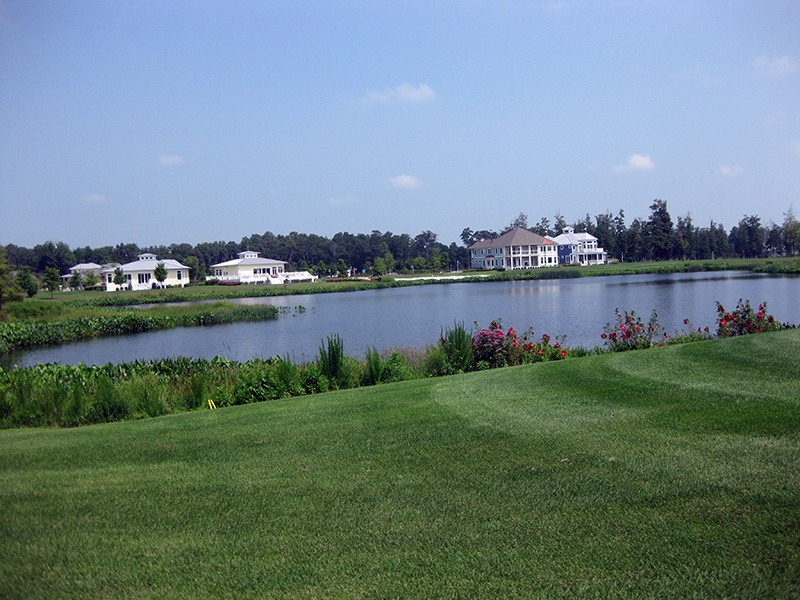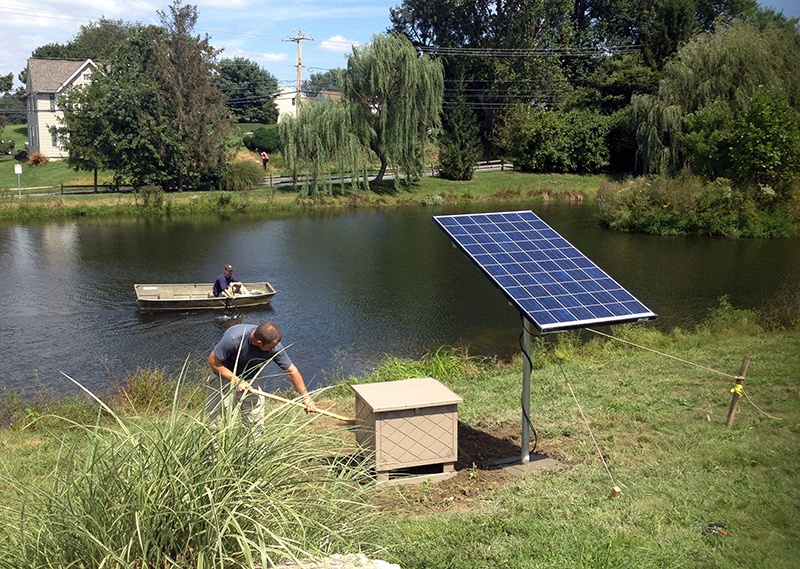Solar Pond Aeration: Harnessing the Power of the Sun
September 10th, 2015
AS SEEN IN North Carolina Turfgrass, A Publication of the Turfgrass Council of North Carolina, July/August: Written by Industry Experts Greg Blackham, Aquatic Specialist, and Gavin Ferris, Ecologist
Managing a golf course can be complicated. Finding solutions that fit within annual budgets — solutions that balance aesthetics, keep the course playable and still coexist with the natural environment — is a challenge. Add the management of multiple ponds to the long list of other course responsibilities, and the task becomes even more daunting.
Golf course ponds often serve as an irrigation source for watering the turf, which limits herbicide compatibility and makes nutrient management all the more important. One critical nutrient mitigation strategy is aeration. As solar technology has improved, the price to implement the power of the sun has become more practical and reliable. Solar aeration can be a useful tool for managing golf course ponds, especially where extending power to the ponds is not feasible.
Greens and fairways require a large amount of water and fertilization. To get this type of water supply, the ponds generally function as a large recirculation irrigation system. They are also the catchall for all nutrient runoff from fertilizer, as well as for other natural organic debris. This pollutes the ponds at an accelerated pace, overwhelming the natural processes that might otherwise be able to effectively mitigate these nutrient loads. The result is unsightly algae blooms, rampant growth of invasive submersed weeds and a precarious situation for all the fish and other wildlife that share the same space.
Nutrient mitigation in a waterbody is solved in a variety of ways, but the tool bag for a golf course manager is severely limited. Since the ponds are used for irrigation, many herbicide solutions to control algae and underwater weeds are not an option, as they cannot be used on the turf. More importantly, constant treatment with herbicides will not ultimately interrupt the nutrient loading cycle, which results in a repetitive need for more treatments in the future.
 One of the best options in the superintendent’s tool bag to prevent the algae blooms and other water quality issues is mechanical aeration. By circulating the water column and allowing bottom water to gather oxygen from the air above, aerobic bacteria thrive. These “good” bacteria work to break down the nutrients from organic debris suspended in the water as well as in the muck at the bottom. As a result, nutrients that would otherwise be available for nuisance vegetation are instead bound in microbial biomass. The oxidizing effect of the aeration process also works to directly change various constituents within the water chemistry, providing direct relief to some of the nutrient loading that is occurring.
One of the best options in the superintendent’s tool bag to prevent the algae blooms and other water quality issues is mechanical aeration. By circulating the water column and allowing bottom water to gather oxygen from the air above, aerobic bacteria thrive. These “good” bacteria work to break down the nutrients from organic debris suspended in the water as well as in the muck at the bottom. As a result, nutrients that would otherwise be available for nuisance vegetation are instead bound in microbial biomass. The oxidizing effect of the aeration process also works to directly change various constituents within the water chemistry, providing direct relief to some of the nutrient loading that is occurring.
As part of a water-quality management strategy, aeration is an excellent way to bring a pond back into balance. For existing golf courses exploring traditional aeration systems, extensive lengths of heavy electrical supply lines would need to be run to each pond. In addition to tearing up the course for electrical installation, installing tens of thousands of feet of heavy-gauge electrical cable is an expensive proposition. Add in the annual operation cost at the meter, and the economic feasibility of aeration diminishes greatly.
Due to these logistic and financial drawbacks, the budget for pond maintenance usually gets sent further and further down the funds-allocation list. For some period following golf course construction, everything seems okay, and the golf course as a whole looks fantastic… until the ponds just can’t handle it anymore. Overgrown areas of algae and weeds, often accompanied by an unpleasant odor, begin to overshadow the entire golfing experience. In addition to being aesthetically undesirable, overabundant algae blooms are environmentally detrimental, and exposure to many of the toxic algae strains has been linked to a number of neurological health conditions in animals and humans. Further, allowing algae to obstruct drainage systems may run afoul of state and local regulations. For these reasons, installing diffused-air systems, powered by the sun, may be a prudent strategy for ponds that could not easily be aerated otherwise.
Solar aeration can be considered when planning either preventative or curative maintenance of the ponds at your course. The setup is simple and effective. An air compressor sits in a sound-reducing cabinet and pumps out air through weighted tubing. Air travels through the tubing to destination diffuser membranes sitting on the bottom of the ponds at key locations. Air that passes through the membranes gets diced into thousands of tiny bubbles that fan out into a large vertical cone as they head for the surface. The bubbles reach the surface and grab oxygen-rich air, after which they float off horizontally and sink back towards the bottom, mixing with the entire water column. These systems are sized to allow for this induced circulation to turn the pond over at least one time per day. The air compressor in the cabinet is powered by a solar panel, and extra reserve batteries can be included to continue operation through the night.
 With the cost of solar panels becoming more affordable, coupled with zero electrical operating costs, solar-aeration systems become an easy, cost-effective solution with incredible value. Used preventively, aeration will more than pay for itself in the long run. Although not necessarily a fix-all solution for mature ponds with complicated nutrient pollution, aeration alone provides greater value than other stand-alone mitigation strategies. As compared to the installation and ongoing electrical costs of traditional aeration systems, a solar-aeration system will cost less in fewer than five years. Many courses are finding no reason to continue to pay for electricity when harnessing the power of the sun has become affordable.
With the cost of solar panels becoming more affordable, coupled with zero electrical operating costs, solar-aeration systems become an easy, cost-effective solution with incredible value. Used preventively, aeration will more than pay for itself in the long run. Although not necessarily a fix-all solution for mature ponds with complicated nutrient pollution, aeration alone provides greater value than other stand-alone mitigation strategies. As compared to the installation and ongoing electrical costs of traditional aeration systems, a solar-aeration system will cost less in fewer than five years. Many courses are finding no reason to continue to pay for electricity when harnessing the power of the sun has become affordable.
When presenting this idea, be prepared for this preconception: the solar panels will detract from the golfing experience. In yesterday’s world, maybe this was the case, but not anymore. As global awareness for environmental responsibility has become a social understanding on a widespread level, golfers will appreciate the incorporation of sustainable-energy practices, even at the micro level. Golf courses that utilize environmentally sustainable “green” technology will be noticed as implementing responsible resource management. Solar panels are becoming widely accepted in the peripheral vision, and they are not viewed as detracting from the golfing experience. This is how pond management and nutrient management are trending into the future, and this is positive!
Solar aeration closely mimics how ponds managed themselves long before excessive human pollution came into the mix. Aquatic organisms use the sun to photosynthesize solar energy into a complicated chain of metabolic energy, in part fueling aerobic bacterial decomposition. Solar aeration at your course can be used as a supplemental companion to nature, making up the difference while keeping your electrical bills low.
Contact the experts at 888-480-5253 for all of your lake, pond and fisheries management needs.
Greg Blackham is an Aquatic Specialist and Gavin Ferris is an Ecologist with SOLitude Lake Management. Since 1998, SOLitude Lake Management has been committed to providing full service lake and pond management services that improve water quality, preserve natural resources, and reduce our environmental footprint. Lake, pond and fisheries management services, consulting, and aquatic products are available nationwide. Learn more about SOLitude Lake Management and purchase products at www.solitudelakemanagement.com.










